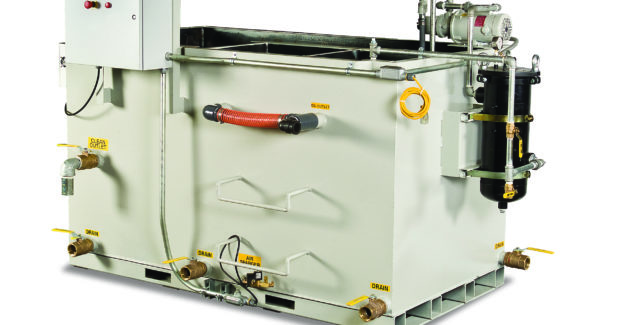Five Ways Metalworking Fluid Recycling Equipment Delivers ROI
Accurate and precise cutting fluid recycling equipment contributes significantly to reducing your shop’s annual cutting fluid management operations.
Posted: January 31, 2022
Finding new ways to reduce costs in metalworking is something every fabricator aspires to. Cutting fluid recycling equipment is proven to generate meaningful savings over time. With that in mind, let’s walk through five ways fluid recycling systems deliver ROI.
Note: Many variables play a role in cutting fluid management. To create a baseline for the following ROI examples, the estimates were established using a metalworking company with these attributes:
- Automotive parts manufacturer in the Midwest
- Has less than 20 machine sumps
- Operates 52 weeks a year
- Lower fluid replacement costs
Cutting fluid recycling equipment significantly reduces the amount of fluid metalworking operations need to replace annually.
Fluid filtration and recycling systems extend cutting fluid life two to five times, lowering new fluid purchase costs up to 75 percent. An automotive parts manufacturer utilizing approximately 1,100 gallons of new concentrate per month at an estimated $19.75 per gallon of concentrate, would see the cost of new cutting fluid come out to around $260,700. Fluid recycling equipment can cut that expense by more than half.
Potential annual savings: $195,525
- Lower haul-away expenses
The ability to reuse fluids also reduces the need to haul spent fluid away. In fact, a fluid recycling system can lower disposal costs up to 90 percent. Although haul away and disposal costs can vary widely — from 20 cents per gallon to hundreds of dollars per drum — tens of thousands of dollars can be saved annually even on the less expensive side of the spectrum. For example, a metalworking operation hauling away 6,000 gallons of spent fluid per month at a rate of 40 cents per gallon is looking at a disposal cost of around $28,800 annually. A fluid recycling system would lower the haul-away expenses to less than $3,000 a year.
Potential annual savings: $25,920
- Labor savings
Automated fluid recycling systems automatically remove tramp oils and suspended solids from contaminated cutting fluids. They control bacteria and adjust fluid concentration for fluid recovery. These capabilities significantly reduce the need for operator intervention in cutting fluid maintenance.
The starting salary for a machine maintenance technician in the Midwest is in the ballpark of $41,000. Although fluid maintenance is sometimes one of several duties for a technician, metalworking operations that can utilize hours previously dedicated to cutting fluid management for other tasks can position themselves to better leverage their workforce.
Potential annual savings: $10,250 (assumes fluid maintenance is only 25 percent of job duties)
- Improved production, extended tool life and better part quality
Automated fluid recycling systems are proven to extend tool life by as much as 25 percent.
For an automotive parts manufacturer with an annual perishable tooling cost of $150,000, increased tool life could save as much as $37,500 annually. That’s not to mention the additional revenue that could be generated by increased uptime (less downtime is needed for tool replacement) and improved surface finish that contributes to better part quality.
Potential annual savings: $37,500
- Lower health and safety risks and improved environmental compliance
The benefits of a cutting fluid recycling system aren’t limited to extending fluid life and reducing new fluid costs. Proper filtration of cutting fluids significantly reduces the amount of tramp oil and bacteria present in the work zone. By decreasing exposure to the hazards that contribute to dermatitis and other illnesses, metalworking operations position themselves for fewer health-related absences and medical claims.
Fluid recycling also generates compliance savings. With the U.S. Environmental Protection Agency’s maximum civil penalty for improper hazardous waste disposal at $70,117 per day, per violation, taking steps to limit hazardous waste incidents is as much a fiscal responsibility as it is an environmental one.
Potential annual savings: Invaluable
With all the potential savings combined, a fluid recycling system would save $269,195 annually. Consult with a trusted fluid recycling equipment manufacturer to inquire about having a sample of your cutting fluid tested. The fluid data will be used to specify the correct equipment solution.

















